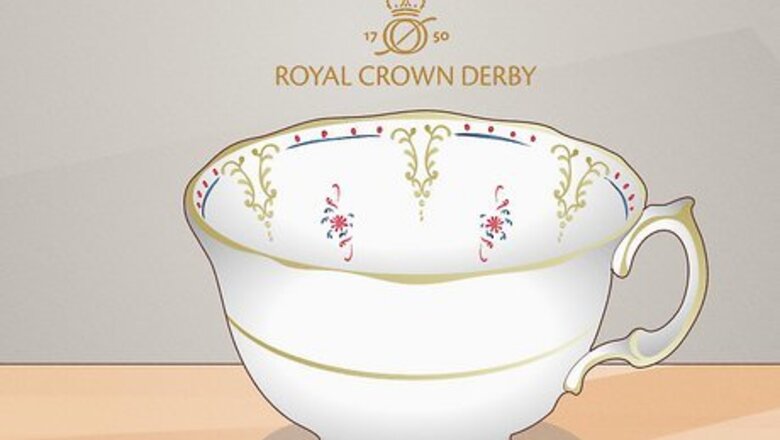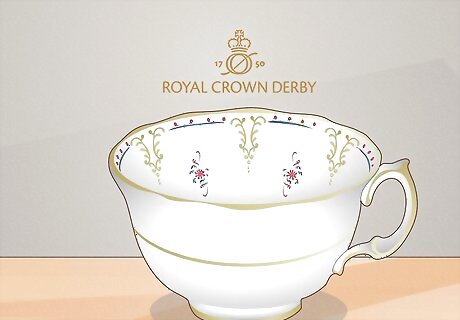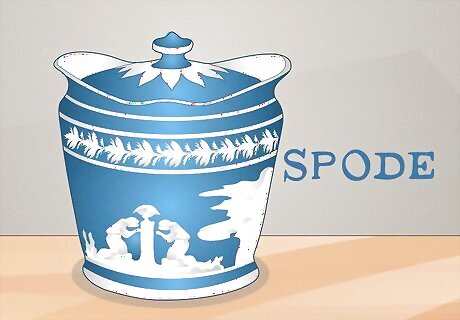
views
Royal Crown Derby Porcelain Company

The Royal Crown Derby Porcelain Company was founded in 1750 and has supplied every British monarch since King George III with exquisite fine bone china pieces. This family-run business supplied the unsinkable Titanic’s first-class dining suites with chinaware and continues to grace tabletops around the world. Identifying Marks: A crown, the words “Royal Crown Derby,” and crossed swords or a symbol that looks like a cursive X in an open circle. Appearance: Look for highly detailed red, blue, and gold designs over delicate white porcelain.
Meissen Porcelain

Founded in 1710 by Augustus the Strong in Germany, Meissen produced some of the finest elaborately decorated white porcelain wares and sculptures in the West. Meissen’s iconic crossed swords mark was first used in 1722, and pieces bearing this mark are highly sought out by collectors and enthusiasts. Identifying Marks: The letters “AR” (for Augustus Rex) or crossed swords, possibly with a signature, a dot, or a star to indicate different periods or artists. Appearance: Generally, the porcelain is smokey-white if the piece was made before 1720. By the end of the 1720s, pieces were more of a brilliant white.
Wedgwood Porcelain

Josiah Wedgwood I, known as the “Father of English Potters,” was a renowned British potter who revolutionized the ceramic industry and advanced firing and glazing techniques. Combining classical elements with contemporary styles, Wedgwood often incorporated designs inspired by nature, mythology, and historical events. Identifying Marks: The words “Wedgwood,” “Wedgwood & Bentley,” “W. & B.,” or “Wedgwood & Sons” either alone or in a circle. Appearance: Wedgwood most famously created “Wedgwood Blue” glaze, a dark baby blue.
Delft Pottery

Originating from Delft, Netherlands, in 1653, Delftware is a type of earthenware that combined European craftsmanship with Asian influences. Authentic Delftware is always hand-painted and often appears in blue or white, although later pottery makers also worked with red, yellow, black, and green. Identifying Marks: The most valuable pieces, made after 1879, are marked by a jar, the initials “JT,” and the word “Delft.” Appearance: Buff or pinkish clay with hand-painted blue and white designs applied with a tin glaze to look like fine Chinese porcelain vases and plates. “Delftware” is not a protected brand name, so some blue and white pieces marked “Delft” might not be original—have a licensed appraiser examine your piece to verify its authenticity.
Coalport Porcelain Company

Coalport (also known as Coalbrookdale) Porcelain was founded by John Rose in 1795 in Shropshire, England. The company used many different marks over the years, but the most valuable pieces tend to be from before 1881. Coalport now produces collectible figurines as part of Wedgwood Porcelain. Identifying Marks: Pieces from 1810 to 1850 are printed with “Coalbrookdale,” “CD,” “C,” or “John Rose & CO.” Pieces from 1881 to 1939 include a crown with the words “England” or “Made in England” and “Coalport.” Appearance: Pieces before 1821 often had a willow pattern with decorative transfer prints. Their pieces became more elaborate, gilded, and ornamental in 1828.
Rookwood Pottery

Rookwood Pottery was founded in 1880 in Cincinnati, Ohio. The company revolutionized the pottery field but struggled through the Great Depression and went out of business in 1967. In 2011, the business was bought by its current owner and has been in limited production since then. Identifying Marks: Pieces made before 1886 has the year in numerals and the name “Rookwood.” Pieces made after 1886 have a backward capital “R” against a capital “P.” A small flame was added around the top of the initials each year until 1900. Appearance: Early pieces typically have a brown, yellow, or amber glaze over depictions of plants or images of people. Pieces made after the 1890s typically have matte glazes.
Spode Pottery

Founded by Josiah Spode in 1770, Spode Pottery is known for its iconic blue and white transferware. Josiah Spode’s son discovered the formula for the new English porcelain, bone china, which took the British pottery world by storm. His patterns ranged from classical motifs inspired by Greek and Roman art to landscapes. Identifying Marks: The word “Spode” (capitalized or lowercase) or “Spode’s Stone China” is painted, impressed, or transfer-printed in underglaze. Appearance: Most pieces are white pottery with blue motif underglaze. After 1824, Spode added other colors, like green, pink, brown, purple, gray, and black.
Roseville Pottery Company

Roseville Pottery, founded in 1890 by J.F. Weaver in Roseville, Ohio, was one of the fastest-growing stoneware pottery companies at the turn of the century. The last original pieces were created in 1954, so pieces made before then are some of the most valuable. Identifying Marks: Pieces are typically marked with the raised word “Roseville,” with numbers indicating the piece’s shape and size. Appearance: Pieces often have bright, colorful floral and plant designs.
Grueby Pottery

William Henry Grueby founded the Grueby-Faience Company in Boston in 1894 and initially created tiles and lamp bases. Later, the company designed hand-thrown Grueby vases glazed in a signature matte green. The company fell into bankruptcy in 1909 and was purchased by the C. Pardee Works until it closed in 1920. Identifying Marks: Typically, pieces are printed with a round stamp with the words “GRUEBY FAIENCE Co / BOSTON. U.S.A.” encircling a flower. Appearance: Typically, this pottery is glazed with the characteristic matte green color William H. Grueby created himself. However, some pieces might be glazed with a mustard yellow.
Moorcroft Pottery

William Moorcroft founded Moorcroft Pottery in 1897, known for its hand-signed pieces. The company continued to evolve with his son, Walter Moorcroft, who introduced exotic flowers and dramatic colors into the traditional Moorcroft design. Today, the English company is internationally renowned, producing unique, timeless designs. Identifying Marks: The hand signatures are “W. Moorcroft,” “MOORCROFT,” or “W.M.” with a factory mark and a pattern or a shape number. Appearance: Typically, vintage Moorcroft pieces have bright glazes with flower or tree designs.
Weller Pottery

Weller Pottery was the first mass producer of Art Deco and Arts and Crafts pottery. The company was based in Fultonham and Zanesville, Ohio, and was in production from 1872 to 1948. Identifying Marks: The word “Weller” in a loopy font, was used most in the 1930s to 1940s. Appearance: Weller is most known for their floral and garden wares. They also made brown and white cooking ware, including bean pots, mixing bowls, mugs, teapots, and tumblers.
Van Briggle Pottery

Founded in 1901 by Artus Van Briggle in Colorado Springs, Colorado, the Van Briggle Company was well-known for its colorful satin matte-glazed pottery. Although Briggle passed away in 1904, the company was led by his widow, Anne, through 1912 and still lives on today. Identifying Marks: One of the most common marks is two “A” letters pressed against each other enclosed in a square. Some pieces include the words “Van Briggle.” Pieces made after 1920 usually have Colorado Springs included to the mark. Appearance: Many Van Briggle pieces are glazed blue-green and made with soft-edged shapes.
Paul Revere Pottery

The Saturday Evening Girls Club was created in 1907 to provide training and employment to poor immigrant girls in Boston, Massachusetts. The club soon grew into a profitable company where girls could earn a living as potters and named it the Paul Revere Pottery Company. Identifying Marks: Most marks consisted of the letters “S.E.G.” for the Saturday Evening Girls until 1925 when the marks changed to “P.R.P” or the Paul Revere Seal with the words “Boston” and “Paul Revere Pottery.” Appearance: Most of the pieces were utilitarian forms glazed in a variety of colors, with pictures of chicks, rabbits, ducks, landscapes, flowers, and other designs.
Newcomb College Pottery

In 1886, Newcomb College opened as the first coordinate college for women at Tulane University in New Orleans. In 1894, the art program directors at Newcomb founded the Newcomb Pottery Enterprise, which became one of the most successful art potteries for almost 50 years. Identifying Marks: Most of the pieces are marked with an “N” inside of a “C.” They also include the initials of the potter and a system of letters that identify the year the piece was made. Appearance: The company is known for its flower, oak tree, and Spanish moss designs. Their soft, romantic matte glaze became popular in 1910, and at the same time shifted towards more representative images.
Teco Pottery

William D. Gates founded the Terra Cotta Tile Works in Terra Cotta, Illinois, making bricks, drain tile, and pottery. Gates experimented with art pottery and in 1902 started the Teco line, which produced mid-century designed matte green vases. Identifying Marks: Most pieces have a large “T” with “eco” written vertically down the side of the letter. Appearance: Pieces often have a matte green glaze, like Grueby’s iconic pieces. However, Teco pottery pieces are often larger, with some reaching over 7 ft (2.13 m) tall.
George Ohr Pottery

George Ohr, also known as the “Mad Potter of Biloxi,” studied art at Newcomb College in New Orleans. He created original, revolutionary pieces with thin walls, vibrant glazes, and twisted, ruffled shapes. In a one-man operation, he used clay that he dug himself to create his pieces and threw every piece personally. Identifying Marks: Most pieces are stamped with the words “G.E. OHR, Biloxi, Miss.” Appearance: Pieces made before 1903 had creative, experimental shapes and colors. Pieces made after 1903 are unglazed and tend to be rarer because Ohr’s production slowed during this period.
Fulper (or Hill) Pottery

(Hill) Pottery The company that later became Fulper Pottery was founded in 1814 by Samuel Hill in Flemington, New Jersey. Hill’s partner Dutchman Abraham Fulper took over the company, and in the early 1900s his sons experimented with colored glazes and created the bright, beautiful vases and lamps they’re known for today. Identifying Marks: The most common mark is an oval or rectangle stamp with the Fulper name, written vertically. Some pieces might also have a paper logo with the model number, form name, glaze, and price. Appearance: Early pottery is earthy and organic, painted with colorful streaked glazes. Later pottery followed more Classical, Art Deco, and Primitive styles.

















Comments
0 comment